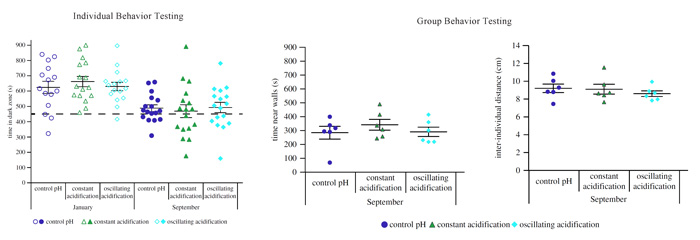| Follow @co2science |
Paper Reviewed
Kwan, G., Hamilton, T.J. and Tresguerres, M. 2017. CO2-induced ocean acidification does not affect individual or group behavior in a temperate damselfish. Royal Society Open Science 4: 170283, http://dx.doi.org/10.1098/rsos.170283.
Introducing their study, Kwan et al. (2017) write that most ocean acidification (OA) studies tend to be conducted in laboratory settings under constant pH values that are projected to occur by the end of this century. However, they note that "this situation does not adequately represent the large, natural variability of coastal environments caused by near shore processes such as upwelling, water advection and primary production," which often produce coastal CO2/pH changes that exceed the predicted pH changes over seasonal and even daily timescales. As an example of this variability, they point to the La Jolla kelp forest, off the coast of San Diego, USA, where seawater pH "can range from 8.07 (pCO2 ~ 246 µatm) to 7.87 (pCO2 ~ 820 µatm) and from 7.80 (pCO2 ~ 353 µatm) to 7.67 (pCO2 ~ 1016 µatm)" at depths of 7 and 17 m, respectively. Sadly, however, they report that "to date there are no reports of fish behavioral or physiological responses to current environmentally relevant CO2/pH variability." And thus they set out to conduct the first such experiment.
The fish chosen for their analysis was blacksmith (Chromis punctipinnis), a damselfish that inhabits southern California waters year-round among the rocky reefs and kelp forests. Juveniles of this species were subjected to three experimental conditions in two separate months of the year: control (January: pCO2 = 549 ?atm, 7.91 pH units; September: pCO2 = 530 ?atm, 7.93 pH units), constant acidification (January: pCO2 = 983 µatm, 7.68 pH units; September: pCO2 = 859 µatm, 7.74 pH units) and oscillating acidification (January: day: pCO2 = 587 µatm, 7.89 pH units; night: pCO2 = 1066 µatm, 7.65 pH units; September: day: pCO2 = 532 µatm, 7.93 pH units; night: pCO2 = 845 µatm, 7.75 pH units). Testing included an evaluation of both individual and group behaviors after CO2/pH treatment exposure of 7 and 11 days, respectively. And what did their study reveal?
In the words of the authors, and as illustrated in the figure below, "neither constant nor oscillating CO2-induced acidification affected blacksmith individual light/dark preference, inter-individual distance in a shoal or the shoal's response to a novel object, suggesting that blacksmiths are tolerant to projected future OA conditions." As for why there was no impact, Kwan et al. opine that it "could be due to a variety of not mutually exclusive reasons," including (1) "blacksmiths may be able to regulate the acid/base status of their internal fluids, so OA relevant elevations in CO2 levels do not affect neuronal function," or (2) "they may be able to regulate neuronal membrane potential to offset potential effects of OA on the chemistry of their internal fluids." Whatever the case may be, one thing is certain, ocean acidification will not be a problem for juvenile blacksmith in the future.

Figure 1. The response of individual Chromis punctipinnis fish placed in a light/dark preference test arena (left panel) and their location recorded for 900 s under the three OA scenarios. (Center and Right Panels) Group OA behavioral testing (five fish per test) of Chromis punctipinnis fish placed into a shoaling test arena to measure their time near walls (center panel) and inter-individual distance (right panel). Data presented as mean ± s.e.m. Source: Kwan et al. (2017).




